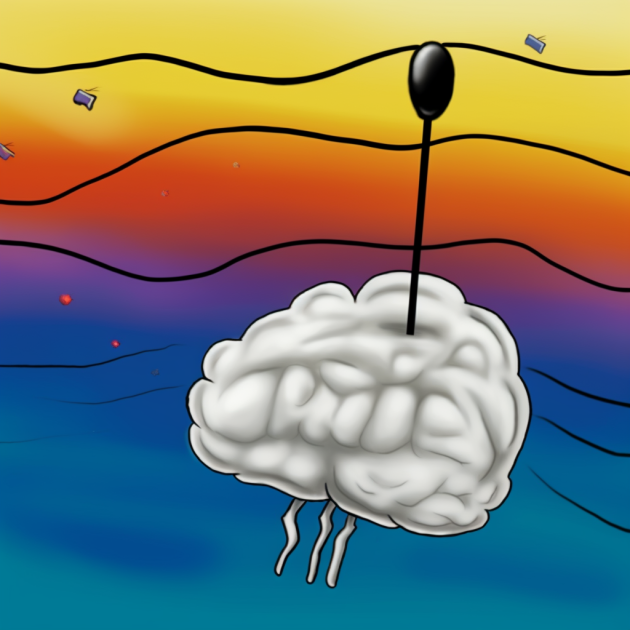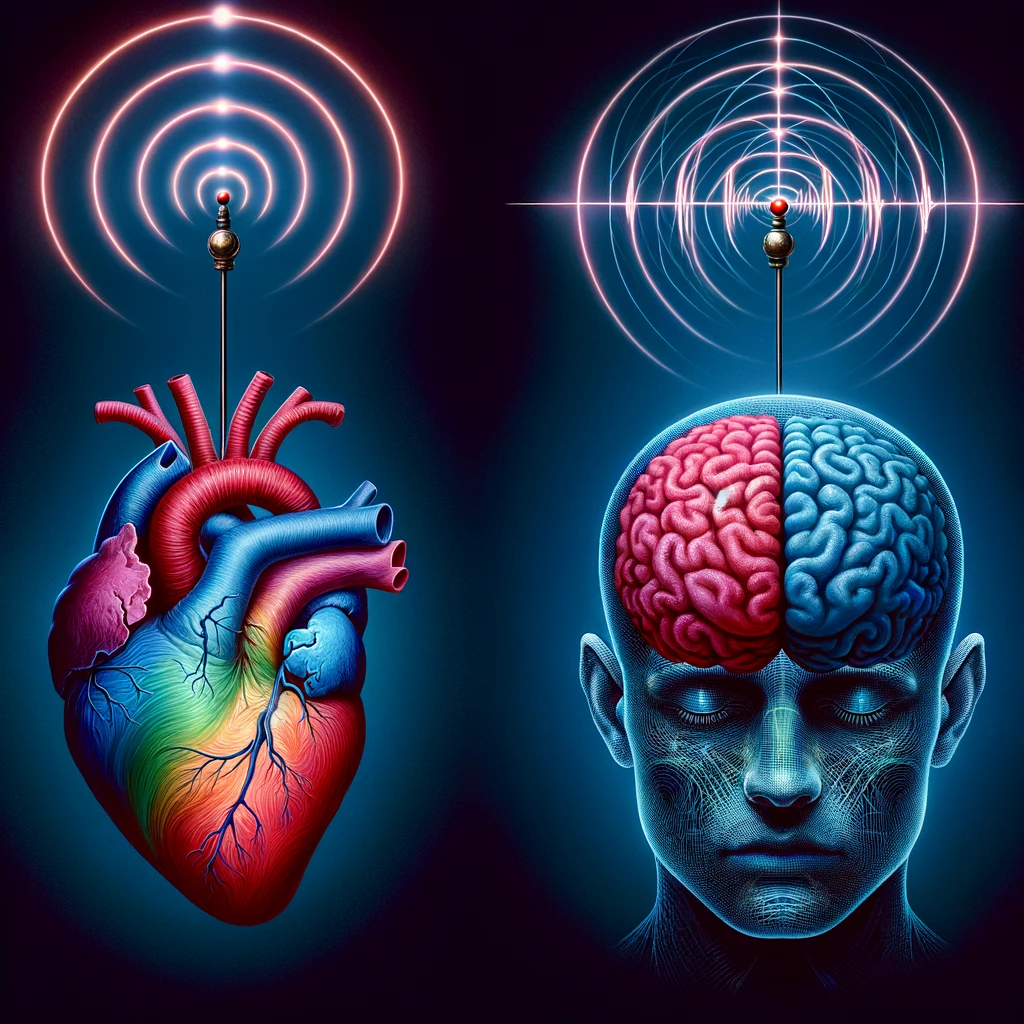While it’s widely accepted among scientists that brain waves can influence chemical reactions and vice versa, this dynamic relationship might just be the surface layer of a deeper, more foundational aspects: the Quantum Self and the LARGER CONSCIOUSNESS FIELD. Sounds too bizarre? Well, does it sound too bizarre to think that the music we hear from an FM radio isn’t actually produced inside the radio itself? Read on to see why this theory gains more and more merit and adoption by renowned scientists and laypeople alike.
Recent studies have illuminated the intricate processes by which our brains form and retrieve memories. Within our biological spacesuit – in this case, the brain – memories are encoded in specialized cells known as engram cells. These cells, predominantly found in the hippocampus for declarative memories and the amygdala for emotional memories, undergo both cellular and genetic transformations during our experiences and learning. They are the keepers of memories, enabling us to be consciously aware of these recollections later on.
Here memory and consciously aware are using lowercase on purpose. This is to indicate memory within a biological spacesuit, and conscious awareness as experienced via the biological spacesuit as well.
This memory process, steered by synaptic connections, is often summed up as “neurons that fire together, wire together.” However, it’s important to understand that the rapid installation of specific receptors/ion channels during periods of rapid learning (particularly under conditions of threat or novelty) facilitates information flow through these “important” channels. For example, during extreme duress, AMPA receptors (which are also ion channels) are quickly installed in the cell membranes of specific neurons. This way, if anything similar should happen in our lives, we have a response encoded (eg fear when we smell a particular scent, etc). A similar route to neuronal encodings (“installations”) is followed when there is something novel happening. In short BIG NEWS, gets a BIG response — rapid memory formation, rapid learning.
When new experiences occur, engram cells in the brain activate a special set of genes called immediate early genes. These genes kick-start the process of encoding these experiences into memory, initiating a series of changes in engram cells that enable the brain to store these experiences as long-term memories. After a short while, the activity level of these genes returns to normal. However, the domino effect of changes initiated by this brief activation continues. This cascade includes alterations in the structure and function of the engram cells, leading to the strengthening of synaptic connections and the creation of new neural pathways. These changes are are responsible for transforming fleeting experiences into stable, long-lasting memories that can be accessed and recalled in the future. Essentially, the activation and subsequent normalization of immediate early genes set the stage for the deep-rooted encoding of memories within the brain’s intricate network.
Sleep, and specifically REM sleep, plays a vital role in memory consolidation. During sleep, the brain actively reorganizes memories, transferring them from the transient hippocampus to more stable, long-term storage areas. This transition is essential for both maintaining and enhancing our learned experiences.
To put it simply, both learning and memory formation in the brain rely on the same fundamental mechanisms. These mechanisms involve cellular changes, the strengthening or weakening of synaptic connections, and the critical role of sleep, especially REM sleep, in consolidating and securing these memories for long-term storage. This unified process underscores the brain’s remarkable capability to adapt and retain a vast array of experiences and knowledge.
“Memory engram cells are groups of brain cells that, activated by specific experiences, change themselves to incorporate and thereby hold information in our brain. Reactivation of these ‘building blocks’ of memories triggers the recall of the specific experiences associated to them.… In 21st century neuroscience, many of us like to think memories are being stored in engram cells, or their sub-components. This study argues that rather than looking for information within or at cells, we should search for information between cells, and that learning may work by altering the wiring diagram of the brain – less like a computer and more like a developing sculpture.… In other words, the engram is not in the cell; the cell is in the engram.” – Dr. Clara Ortega-de San Luis
What if there’s and engram (local engram) and an Engram (nonlocal)?
Quantum Consciousness theories suggest that Consciousness is a fundamental aspect of the universe. In this framework, the Engram could be thought of as a part of this infinite field of Conscious Awareness. This implies that our personal memories and conscious experiences, while being processed and localized within our brain, might also have a counterpart or connection to this universal field of consciousness, a.k.a. the LARGER CONSCIOUSNESS FIELD.
Moving beyond the biological machinery of memory in the brain, we can embrace (speculate, muse on) the nonlocal mind theories. This theory (from quantum physics) acknowledges an infinite field of Conscious Awareness and Knowing. It offers explanations for everything paranormal and the nature of a Quantum Self (or Spirit). Our personal conscious awareness and memories are localized within a biological spacesuit. The access to information that we have is LIMITED when we are in our bodies. I like to explain this as a Quantum Self being projected through a biological spacesuit. Depending on the settings, structure, and systems in the biological spacesuit we have access to certain bits of info. But there is SO. MUCH. MORE. info that is “out there” …. “beyond.”
In this model, the brain serves as an antenna, receptor and decoder for this Consciousness field. The Record of all experiences remains intact in the nonlocal mind. So even if the biological apparatus is damaged, the potential to access the full Record persists. Phenomena like terminal lucidity give us glimpses into this truth.

Terminal lucidity refers to sudden moments of clarity in those with severe cognitive impairments from disorders like dementia. Somehow, even while the brain is hugely compromised, individuals gain temporary access to vivid personal memories and identity. This suggests the brain can, under unique circumstances, resonate with Conscious Awareness and its perfect Record despite localized damage.
My first thoughts about this involved wondering if the temporal lobe may serve as receptors for these nonlocal transmissions. Terminal lucidity often coincides with pre-death experiences where deceased loved ones arrive – implying expanded connectivity to the Quantum Self AND the superconscious. The temporal lobe has been a region of interest in investigating the paranormal (mediums, etc). However, some terminal lucidity cases involve people getting up out of bed and walking around… something they haven’t done for years. Did the dementia keep them bedridden? If yes, this temporal “theory” (I use the word theory really lightly here) might bode well. But if the person was bedridden due to physical injury, then terminal lucidity might be a full-bodied energetic experience that I can’t even begin to muse about at this point! So let’s get back to the simpler (ha ha) idea:
By recognizing the brain as an instrument for filtering and expressing Consciousness, we open to realities of identity and memory that transcend local biology. We can view then:
- memory and Memory
- conscious awareness and Conscious Awareness
- record and Record
- self and Self
Terminal Lucidity “It’s undeniable that it happens”
NDEs (Near Death Experiences)
Many validated and verified NDE accounts involve a “brain that was mush,” yet experiencers were not only having an experience via Conscious Awareness, they often came ‘back’ to speak of things they should not have known about. For example, Pam Reynolds’ near-death experience (NDE) during her brain surgery in 1991 presents a compelling case for Consciousness beyond brain function. Despite undergoing a surgical procedure that involved cooling her body and completely stopping her brain activity, Reynolds reported vivid and detailed perceptions of her surroundings. Her descriptions of the operating room, the surgical instruments, and conversations among the medical staff, which she accurately recalled, defy conventional understanding since her brain was clinically non-functional at the time. This challenges the notion that consciousness is solely a product of brain activity, as Reynolds demonstrated awareness and memory formation in a state where such neurological processes should have been impossible. Her case remains a significant point of reference in discussions about the nature of consciousness and its potential independence from the physical brain. More recently, the case of Dr. Eben Alexander, a neurosurgeon who experienced a profound near-death experience (NDE), further demonstrates the concept of Consciousness existing beyond the body. During a week-long coma caused by severe meningitis, Alexander’s neocortex—the part of the brain responsible for sensory perception and conscious thought—was completely inactive. Despite this, he recounted an intricate and vivid journey into a realm beyond the physical world, filled with profound insights and encounters with a transcendent presence. His experience, which occurred at a time when his brain was incapable of producing complex thoughts and hallucinations, challenges the conventional medical understanding that consciousness is entirely rooted in brain activity. Alexander’s NDE adds to the growing body of anecdotal evidence suggesting that consciousness can exist in a state separated from the neurological functions of the physical brain, inviting further exploration into the mysteries of human consciousness and its connection to the universe.
Idk. Isn’t This All Coming From the Brain?
You are not alone if you learned this and believe this. Many scientists and researchers adhere to the prevailing theory that consciousness is a product of our brains.

This theory posits that the brain serves as the epicenter of our thoughts, memories, and conscious experiences. But as we experience life and learn of the experiences of others, we realize that this theory is akin to believing that the music coming out of a radio originates solely from the device itself.

This brain-based approach faces several significant challenges. One of the fundamental issues lies in explaining the unity of consciousness – how all our sensory experiences, thoughts, and emotions seamlessly merge into a single, coherent stream of awareness. Sure, scientists talk about sweeping brain waves (like the wave we do at the stadium) as a potential source of this stream… But again, is Taylor Swift trapped inside my FM radio producing the (sound) waves? Emergence is another conundrum within this framework. Some brain-based theories propose that consciousness emerges from the intricate interactions among neurons. Still, the precise mechanism of this emergence remains poorly understood. How do the firing of neurons and the connections between synapses give rise to the rich and intricate landscape of conscious experiences that we encounter daily? And perhaps the most infamous challenge is the “hard problem of consciousness” articulated by philosopher David Chalmers. This problem revolves around the question of why and how physical processes in the brain give rise to conscious experience.
Brain-bound consciousness theories cannot explain the (often validated and verified) “psi” accounts such as NDEs, shared crossing, terminal lucidity, telephone telepathy, why Reiki works, mediums, psychics, past life memories, etc, etc. All of these instances suggest that our consciousness may extend far beyond the material confines of our biological spacesuits. More and more scientists (and people no matter their job) are embracing a post-materialistic theory that flips the materialistic view on its head.

Hmmmm, you may say…. This sounds very bizarre.
…Did You Say Bizarre?
I’ll give you bizarre. A young girl received a heart transplant from a murdered girl. After the transplant, she began having vivid nightmares about the murder, eventually leading to the identification and conviction of the killer. More widely known is Claire Sylvia’s case: After receiving a heart-lung transplant, Claire started experiencing sensations and cravings (chicken nuggets, beer, and Snickers!) thanks to her donor! She had dreams and intuitions that led her to believe she had taken on some aspects of her donor. This mysterious connection inspired her to search for her donor’s identity, ultimately leading to a meeting with Tim’s family, who confirmed her suspicions. I have questions:
- Do our hearts also have engram cells? …Or another means of storing a local record?
- Do other organs?
- Is this why twins experience twin telepathy? (Their receivers are so similar… they pick up the same radio station?)
- How cool is this?

Further Reading
I would have 50 million things I would want to suggest as “further reading”… Here are some to get you started based on the topic of today. 🙂
Local Memory Formation/ Consolidation:
- MIT News – Molecular mechanism that allows memories to form
Neuroscientists discovered that the formation and recall of memories in the brain is controlled by large-scale chromatin remodeling in engram cells. This process involves epigenomic modifications, which alter the structure and accessibility of chromatin—a complex of DNA and proteins. The research, conducted using genetically engineered mice, revealed that memory encoding and consolidation occur in multiple stages, with specific genes becoming active over several days. These changes primarily occur in noncoding DNA regions called enhancers, which are crucial for activating gene expression during memory recall. This enhances the connections between neurons, deepening our understanding of the molecular mechanisms underlying memory formation and recall.
AMPA Receptors:
Terminal and Paradoxical Lucidity
- Terminal lucidity: a review and a case collection
Explores the phenomenon of terminal lucidity, where patients with severe mental disorders experience an unexpected return of mental clarity and memory shortly before death. The study covers a range of cases from the past 250 years, including those with Alzheimer’s, schizophrenia, and various neurological conditions like brain tumors and strokes. It highlights how diagnoses in historical cases were often inadequate or absent, and notes a decline in medical discussion of this phenomenon in the 20th century. The authors aim to encourage further research into this area to deepen the understanding of the relationship between mental and physical health and to potentially guide new therapeutic approaches. - What is paradoxical lucidity? The answer begins with its definition
Paradoxical lucidity refers to unexpected and temporary episodes of clear communication or behavior in patients with severe dementia, often occurring near death, despite their progressive cognitive decline. This phenomenon, while not fully understood neurobiologically, has been observed in response to stimuli like music or familiar voices. Recognizing its potential to transform our understanding and treatment of dementia, the U.S. National Institute on Aging has prioritized research in this area. However, the current definition of paradoxical lucidity is considered vague, necessitating refinement for effective clinical research. The article emphasizes the need for a more precise definition to guide future studies, thereby enabling a better understanding of this phenomenon and its implications for dementia care. - Paradoxical lucidity: A potential paradigm shift for the neurobiology and treatment of severe dementias
Address the phenomenon of unexpected cognitive clarity observed in patients with severe dementia, often near the time of death. This phenomenon, historically noted but scarcely studied scientifically, challenges the current understanding of dementia as an irreversible condition. The research underscores the importance of systematic investigation into these lucid episodes, which vary in timing and duration, often occurring shortly before death and ranging from a few seconds to several days. The article also draws parallels with related phenomena such as near-death experiences and unexpected arousal, suggesting potential neurobiological mechanisms like surges in neurophysiological activity and neurotransmitter levels. This emerging line of inquiry could fundamentally alter the perception of dementia’s neurobiology and open new pathways for treatment, emphasizing the potential for some level of cognitive function recovery even in advanced stages of the disease. - Reports About Paradoxical Lucidity from Health Care Professionals: A Pilot Study
In this pilot study aimed at developing a structured interview tool for health care professionals to report paradoxical/terminal lucidity (PL), a phenomenon where patients near death show unexpected mental clarity, 73% of the interviewed professionals reported witnessing PL. The study utilized a detailed questionnaire to capture various aspects of lucidity, including duration, content, and context. Results indicated a range of experiences, with some episodes lasting several days and others less than a day. The study underscores the historical recognition of PL, dating back to the 19th century, yet points out the scarcity of systematic evidence in the modern medical field. This highlights the need for further research to better understand PL and its implications in end-of-life care.
Nonlocal Mind
NDE’s
- Beyond the Brain E-book (98 pages)
- IANDS YouTube Channel and Website.
Near-Death Experiences (NDEs) have been extensively studied by organizations like the International Association for Near-Death Studies (IANDS). These experiences often involve individuals on the brink of death reporting profound encounters, such as floating above their bodies, meeting deceased loved ones, and experiencing a sense of peace and love. These accounts suggest that consciousness can operate independently of the brain, even when it’s in a non-functional state.
